Clubroot is a significant disease of canola in Western Canada and has been found in multiple fields and regions in Ontario. Once clubroot is established in a field it cannot be eradicated. Symptoms include galling of roots leading to wilting, stunting and yellowing of plants. Yield loss can range from 0-100% in areas of fields where spores are present. Clubroot can affect spring and winter canola.
Comprehensive information on clubroot can be found in the Canola Council of Canada’s online resources at www.clubroot.ca
Biology
Clubroot is a very persistent and unusual soil-borne organism that requires Brassica plants for reproduction. Resting spores exist in upper soil layers for up to 20 years. They are stimulated to germinate and become zoospores (motile asexual spore) when canola or other Brassica species roots release nutrients. Zoospores have flagella (whip-like tails) that allow them to swim towards roots. They move into root hairs, and a few days later secondary zoospores are released to the soil. These secondary zoospores can then infect the entire root surface, not just root hairs, and cause the symptoms that lead to yield loss.
As disease spreads through the root tissue, a hormonal response causes excessive root growth, producing the clubbed or galled root symptoms that clearly identify the disease. Clubbed roots cannot take up nutrients or water properly, which leads to aboveground symptoms and potentially plant death. As the roots decay, new resting spores are released to the soil.
The initial zoospore can easily swim towards roots when conditions are wet. If soils are dry the short-lived zoospore may not reach the roots, so in dry years there is generally less clubroot infection. Raising soil pH above 7.2 can also slow spore germination and infection but does not prevent disease development. Soil temperatures of 18 to 25°C favour disease development.
If infection occurs early in the season, greater numbers of secondary zoospores are produced leading to greater yield losses. Light levels of infection may not cause yield loss, but billions of resting spores can still be released from a single infected root.
Identification
Above ground symptoms are similar to other diseases, nutrient deficiencies or environmental factors including yellowing, wilting, stunting, premature ripening and plant death. Symptoms will appear in patches, often in wet areas or near the field entrance. When infection occurs late in the season or at low levels, above ground symptoms and yield loss may not be observed.
Infected canola roots are galled or fattened. There may be a small gall on one root hair or rootlet, or the entire taproot may be significantly galled. Galled roots are spongy or marbled in appearance when cut open and decompose to a peaty or saw dust-like texture.
Soil can be tested for the presence of clubroot spores to identify clubroot-positive fields. Galled roots can also be tested to confirm the presence of clubroot.
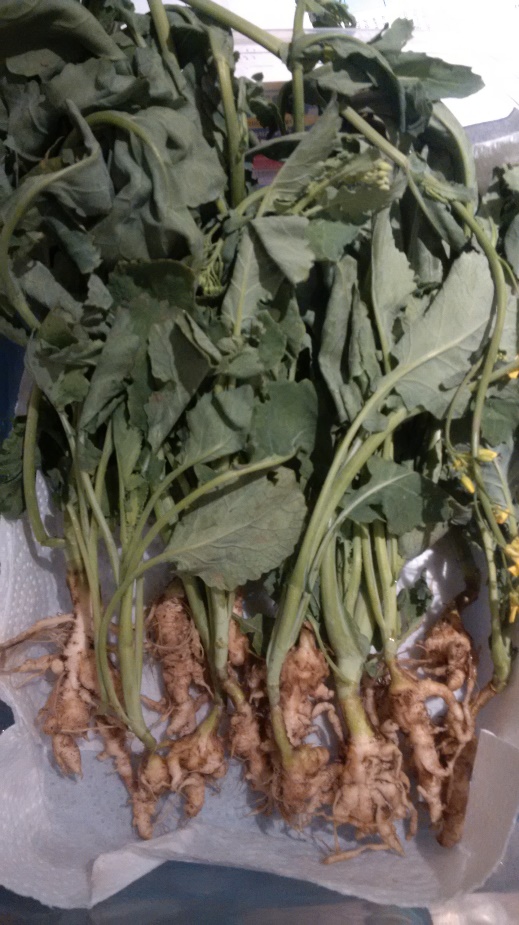
Figure 1. Severe galling of roots infected with clubroot. These symptoms will result in significant yield loss.
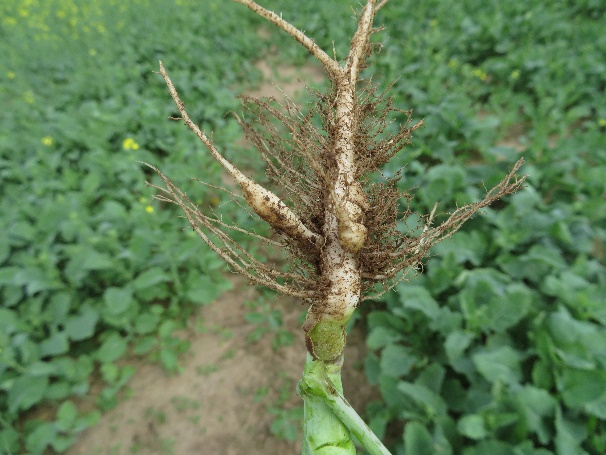
Figure 2. Minor galling on canola roots. This level of galling does not significantly affect root function and may not result in yield loss.
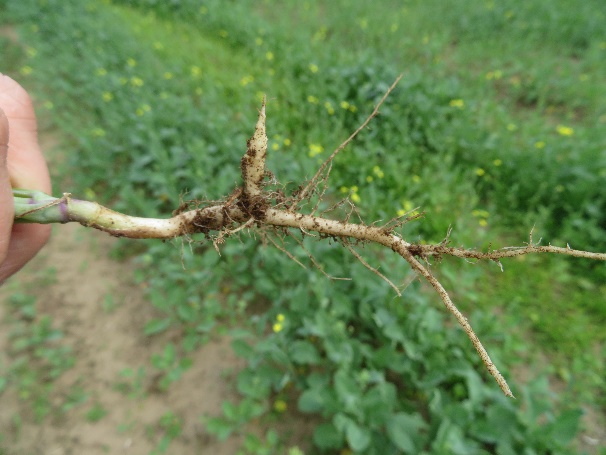
Figure 3. Initial stages of clubroot infection on roots are easy to miss; inspect roots carefully when scouting.
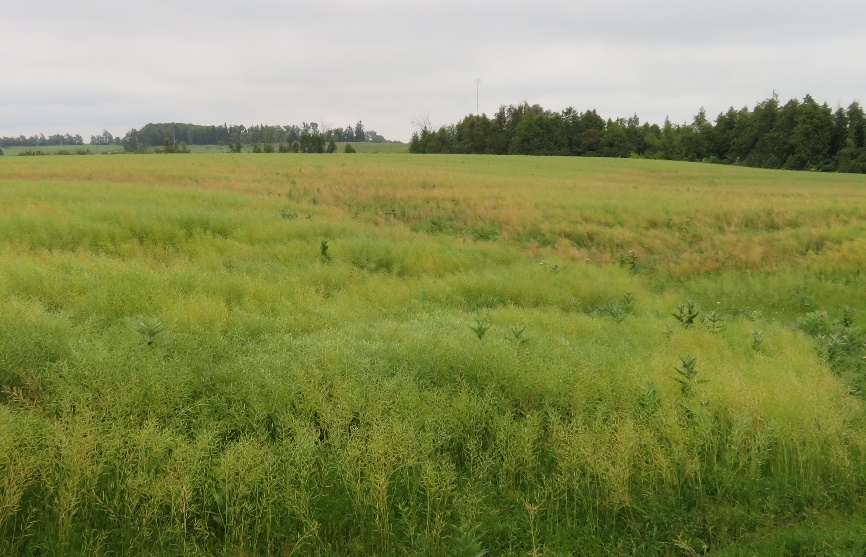
Figure 4. Premature ripening (straw coloured plants) caused by clubroot in area where water runs through the field.
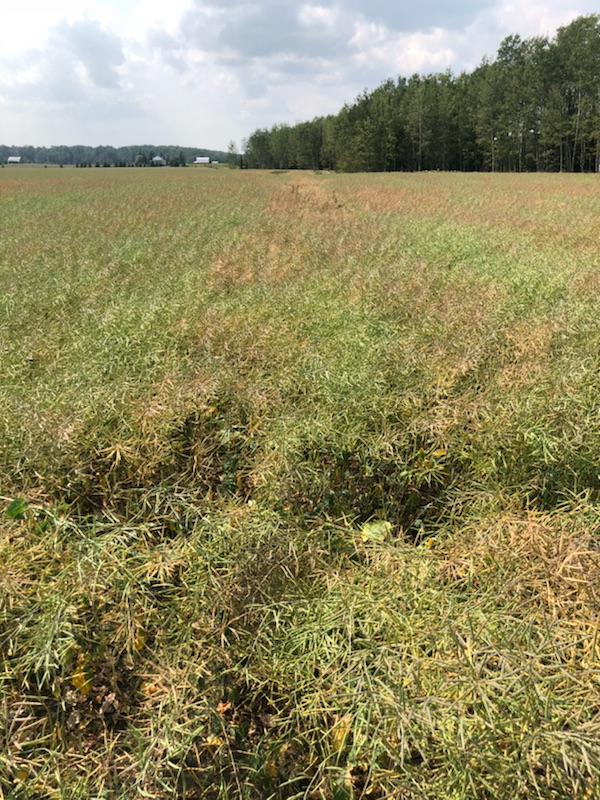
Figure 5. Premature ripening (straw coloured plants) caused by clubroot in strips where equipment tracked spores through the field after picking up soil in another contaminated field.
Scouting Notes
Ontario canola producers should monitor every canola field for clubroot. Plants should be pulled up in wet areas or near the field entrance to look for clubbed roots. Regardless of the assumed diagnosis, plants with above-ground symptoms should be dug or pulled up to check for root galls. Scouting should still be conducted in fields of clubroot resistant canola, because use of resistant varieties may only slow the development of clubroot in a field, not prevent it entirely.
Crop Rotation
The key to managing clubroot is to keep spore concentrations low, and long crop rotations are the best way to achieve that. The half-life for clubroot resting spores is just under 4 years, so keeping Brassicas out of the rotation for 4 to 5 years mitigates build-up. Research shows a 2-year break from canola can reduce spore counts by 90%. However, where fields have very high spore concentrations a reduction of 90% may not be enough to mitigate infection. Long crop rotations must be paired with control of volunteer canola and Brassica weed species in order to limit spore build-up.
Spring cereals and field peas have been shown to reduce resting spore concentrations compared to leaving soil bare in growth room trials. The spores are stimulated to germinate but cannot complete their life cycle because there is no Brassica species present to infect.
Resistant Varieties
The root hairs of both resistant and susceptible canola varieties are infected by the initial zoospore released from resting spores in the soil. However, secondary zoospores are not able to infect the roots of resistant varieties, so symptoms and yield loss do not occur.
There are different pathotypes of clubroot in Canadian soils, which are essentially different strains of the disease. A clubroot resistant canola variety will only protect against specific pathotypes. Clubroot-positive fields in Brassica vegetable production (cauliflower, broccoli, cabbage etc.) in Ontario were confirmed as having pathotype 6 in surveys from the 1970s. In Ontario, pathotypes 2, 2x, 5, 5x and 8 have been confirmed in canola.
Resistant varieties can lose their utility over time, and this has been the experience of canola growers in Western Canada and Ontario. Growing a variety that is resistant to one pathotype creates a selection pressure that allows proliferation of other pathotypes. For example, where varieties resistant to pathotype 3 have been used in clubroot-positive fields in Alberta, the canola is now being infected by pathotype 5x. If a field has moderate to high levels of clubroot spores, it is highly possible more than one pathotype is present. Resistant varieties should be used in conjunction with other best management practices to delay the establishment or development of disease on a farm.
Use of resistant varieties is encouraged in Ontario fields where clubroot has been detected and for growers that are at risk by being near infected fields or sharing field equipment. Resistant varieties are particularly useful prior to infestation, or where spore concentrations are relatively low and long (3 or 4 year) rotations are in place but may struggle to yield where spore concentrations are high and multiple pathotypes are present. Seed for clubroot resistant varieties is typically the same price as non-resistant varieties, so purchasing seed is not cost prohibitive. In Ontario, most seed companies are offering one or two clubroot resistant varieties.
Control Host Plants
Billions of resting spores can be released from the roots of a single infected plant. Clubroot can infect all Brassica plants which includes crucifer crops such as cauliflower, broccoli, kale, turnip, etc., as well as weed species such as wild mustard, shepherd’s purse, yellow rocket, stinkweed, etc. Some cover crop or feed mixes may include Brassica species. Brassica weeds and volunteer canola should be controlled within 1 to 3 weeks of emergence to limit clubroot infection and the contribution of spores back to the soil.
Limit Movement of Contaminated Soils
Clubroot can be transferred in any way that soil moves from field to field, including through water movement, wind erosion and on farm equipment. If there is clubroot in one field within a farm operation, the producer may attempt to limit the movement of soil from that field into other fields. Clubroot within the region may move to a farm field through erosion or via custom operator’s equipment or other shared equipment.
Equipment sanitation between fields can reduce the spread of the disease but is extremely time consuming. Rough cleaning or scraping loose soil off equipment and tires between fields can take as little as 20 minutes and can remove 90% or more of clubroot spores present on the equipment. Recall that a few spores can turn into billions of spores over the course of one season, so this level of cleaning is reasonably easy and effective. This is recommended for all producers in areas where clubroot has been detected, where equipment or custom operators are shared with those working in clubroot-positive fields, or for producers who feel they are at risk. Work in infested fields last and try not to run equipment in fields with wet soils that will cake on equipment and tires. Follow up with pressure washing and sanitizing with a 1% bleach solution when equipment is put away. For more information, view this sanitation guide.